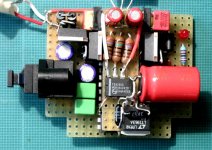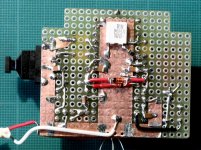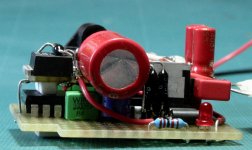I built my first nos 'DanDac' [sorry Peter
 ] over the weekend.
] over the weekend.
It is designed for portable audio use and therefore intended to
be permanently connected to an amp and enclosed in a single small box.
I first connected it to my Stax 4040 /Arcam CD23 rig........
And it worked!

Powered by a tired pp3 9v battery and using a crappy string of
plugs tacked to the outputs, the sound was...surprising.
Compared to the Arcam I thought it lacked a little in dynamics
but hey!
When connected to a small op based headphone amp [a design
called the Pimeta..check out head-fi] and supplied a signal by
a Sony dj925 pcdp ,listening through Beyer 931s, the sound was
far more dynamic .
A system synergy thing I guess.
What to make of the sound?
I don't know yet.
I had consumed a couple of fine ales and it was rather late when I
auditioned it.
Initially I found myself wondering about the treble levels not being quite there.[My stax setup has a quite well lit sound]
But there was also something rather nice about vocals that grabbed me too...
Definitely something different from the norm here..
On the whole a thumbs up thus far.
Thanks to everyone here who has given advice and steepened my
learning curve

Setmenu
It is designed for portable audio use and therefore intended to
be permanently connected to an amp and enclosed in a single small box.
I first connected it to my Stax 4040 /Arcam CD23 rig........
And it worked!

Powered by a tired pp3 9v battery and using a crappy string of
plugs tacked to the outputs, the sound was...surprising.
Compared to the Arcam I thought it lacked a little in dynamics
but hey!
When connected to a small op based headphone amp [a design
called the Pimeta..check out head-fi] and supplied a signal by
a Sony dj925 pcdp ,listening through Beyer 931s, the sound was
far more dynamic .
A system synergy thing I guess.
What to make of the sound?
I don't know yet.
I had consumed a couple of fine ales and it was rather late when I
auditioned it.
Initially I found myself wondering about the treble levels not being quite there.[My stax setup has a quite well lit sound]
But there was also something rather nice about vocals that grabbed me too...
Definitely something different from the norm here..
On the whole a thumbs up thus far.
Thanks to everyone here who has given advice and steepened my
learning curve
Setmenu
Attachments
You seem to be using BG N caps. You probably know it by now, but polarity on those caps is quite important. My preference is for Non Polar (marked) lead to be on pos. supply and on the input signal (from DAC).
If you are missing highs, Rikens are the way to go. They were the best of all resistors that I tried.
Very nicely done, BTW
PS: Those are not OsCons in receiver bypass?
If you are missing highs, Rikens are the way to go. They were the best of all resistors that I tried.
Very nicely done, BTW
PS: Those are not OsCons in receiver bypass?
Hi Peter
I am pleased you like it.
As you can see, it was inspired by your 'ultimate dac layout'
The caps have their long lead acting as 'positive', I used the
polarized BG caps as a guide here, hope this is correct?
And yup, those ARE Oscons you see...
As for the Rikens, I would love to try them but availability in the UK is zero.
Ordering from the Netherlands is a possibility, but it can
be costly for just a few resistors!
The resistors I have used are a tantalum variety from a company in the UK called HI FI Collective, they now stock Audio Note's range
of discreet components.
I have not compared them to any thing else though,just stuck them in there on blind faith...much like the rest of the project..hehe
On the whole I am pleased with the sound of this unit .
.
And that sound certainly has 'something' about it.
Cheers
Setmenu
I am pleased you like it.
As you can see, it was inspired by your 'ultimate dac layout'
The caps have their long lead acting as 'positive', I used the
polarized BG caps as a guide here, hope this is correct?

And yup, those ARE Oscons you see...
As for the Rikens, I would love to try them but availability in the UK is zero.
Ordering from the Netherlands is a possibility, but it can
be costly for just a few resistors!
The resistors I have used are a tantalum variety from a company in the UK called HI FI Collective, they now stock Audio Note's range
of discreet components.
I have not compared them to any thing else though,just stuck them in there on blind faith...much like the rest of the project..hehe

On the whole I am pleased with the sound of this unit
And that sound certainly has 'something' about it.
Cheers
Setmenu
Bricolo said:Nice looking board!
I see you're using the LT1963, have you compared it to other ones?
Hi Bricolo
Thanks.
I have not done any comparisons as yet.
If I recollect these are the quietest ldo regs available.
I am listening to the dac [or should that be listening to music] at the moment, it sounds great
This is is going to be one killer portable setup
Cheers
Setmenu
sorry for my ignorance, but what advantage does putting the Black Gate Ns with one side to positive?? Surely by definition the N is non-polar? I've just finished something using the N-types and didn't bother worrying about that, and it's got different orientations in different parts of the circuit: on every opamp one N-type is the right way round, and the other is the wrong way round (between +,- and ground). Will this be a bad thing??
and setmenu, nice DAC again, saw it over at Head-Fi already
g
and setmenu, nice DAC again, saw it over at Head-Fi already
g
The treble seems pretty ok at the moment, I look forward to
whether I hear any improvements with the Rikens though.
As for re-clocking,space is a big issue with this application,
besides I am still happy with it as is.
audionut, does your dac use passive or active IV conversion?
Regarding the Black gates, I would guess they probably do
not have 100% symmetrical construction, this may explain why
BG do indicate a polarity with lead length.
I do try to aim for consistency when installing components with 'polarity' if one is indicated.
Hey guzzler do you think it is a wise thing to admit to being
a headphone enthusiast around these forums?
Especially with talk of p o r t a b l e audio, got to be courting
a ban with that one


Setmenu
whether I hear any improvements with the Rikens though.
As for re-clocking,space is a big issue with this application,
besides I am still happy with it as is.
audionut, does your dac use passive or active IV conversion?
Regarding the Black gates, I would guess they probably do
not have 100% symmetrical construction, this may explain why
BG do indicate a polarity with lead length.
I do try to aim for consistency when installing components with 'polarity' if one is indicated.
Hey guzzler do you think it is a wise thing to admit to being
a headphone enthusiast around these forums?
Especially with talk of p o r t a b l e audio, got to be courting
a ban with that one
Setmenu
setmenu said:The caps have their long lead acting as 'positive', I used the
polarized BG caps as a guide here, hope this is correct?
And yup, those ARE Oscons you see...
guzzler said:sorry for my ignorance, but what advantage does putting the Black Gate Ns with one side to positive?? Surely by definition the N is non-polar? I've just finished something using the N-types and didn't bother worrying about that, and it's got different orientations in different parts of the circuit:
Well, although BG N are non polar, they are still directional, and short lead, or NON POLAR print, marks the start of the foil.
It is only my personal experience, but in my setup the caps sounded better when short lead was on positive supply. Also, for coupling, I prefer to connect output from the chip to shorter lead. The difference in sound is quite noticable. It is also in line with shielding properties of outer foil, which is recommended to be either connected to ground or to be on the output.
As to the OsCons, if those are the cheap ones with magnetic leads, I recommend you replace them by BGs N type. On the receiver, I don't see a need for anything bigger than 4.7u and smaller caps actually sound better, providing more presence. Those OsCons were far from sounding right. (This may not apply to the better, for audio, grade).
If you do all those changes, your highs should improve
Hi Peter
Well it seems my BG caps are connected oppositely from yours then.. hmm. [not really practical to change them now....on to the the next dac then!]
As for the Oscons they are the non magnetic audio grade SP variety [22uf].
The minimum cap values I can use are in part dictated by those
LDO regs, the data sheet states min 10uf.
I was intending to put 33uf BG N caps into the next model,
I am a little reluctant to use exactly 10uf [besides space considerations] due to tolerance allowing values to fall below
the regulators required minimum 10 uf.
As for the sound of this unit, It does have it's own signature of
course.
Sometimes I find there to a little excess energy in some of the mids.
As to how much this bothers depends on material.
At times I can find it the devils own job assessing the sound of audio equipment.
I look forward to hearing the next dac with those few component changes [whatever they ultimately may be]
Setmenu
Well it seems my BG caps are connected oppositely from yours then.. hmm. [not really practical to change them now....on to the the next dac then!]
As for the Oscons they are the non magnetic audio grade SP variety [22uf].
The minimum cap values I can use are in part dictated by those
LDO regs, the data sheet states min 10uf.
I was intending to put 33uf BG N caps into the next model,
I am a little reluctant to use exactly 10uf [besides space considerations] due to tolerance allowing values to fall below
the regulators required minimum 10 uf.
As for the sound of this unit, It does have it's own signature of
course.
Sometimes I find there to a little excess energy in some of the mids.
As to how much this bothers depends on material.
At times I can find it the devils own job assessing the sound of audio equipment.
I look forward to hearing the next dac with those few component changes [whatever they ultimately may be]
Setmenu
audionut said:In answer to your question on the DAC output...It is passive...8 parralel chips give plenty of drive
A bit power hungry for my current app, not to mention bulky..
As I have plenty of 1543s I will have to give a parallel
arrangement a try when this project is sorted.
Considering these are obsolete economy chips and how badly
such nos dacs seem to measure ,I find my self pretty amazed
at the sound
Cheers
Setmenu
setmenu said:The minimum cap values I can use are in part dictated by those
LDO regs, the data sheet states min 10uf.
I was intending to put 33uf BG N caps into the next model,
I am a little reluctant to use exactly 10uf [besides space considerations] due to tolerance allowing values to fall below
the regulators required minimum 10 uf.
I wouldn't be that much concerned with reg datasheets. One way to decide on the best caps is to mount sockets and switch caps conveniently. I tried 33u BG N at the receiver and the sound became too thick and with less presence to my taste. I believe that 10u might be actually the best choice (in BG N caps of course, as other caps may behave differently).
My experience with AN tantalums is that they lack high frequency extension (very good midrange, bass and body, but lack of air).
Peter Daniel said:
I wouldn't be that much concerned with reg datasheets. One way to decide on the best caps is to mount sockets and switch caps conveniently. I tried 33u BG N at the receiver and the sound became too thick and with less presence to my taste. I believe that 10u might be actually the best choice (in BG N caps of course, as other caps may behave differently).
My experience with AN tantalums is that they lack high frequency response (very good midrange, bass and body, but lack of air).
You hit the nail on the head with the tant description!
I love air in my music [ my Stax setup has it in spades] .
whilst the nos sound is nice, a little more air would be very
pleasant.
I am definitely looking forward to those Rikens now
As for those regs, I just wanted to play safe.
I have this fear of them ringing like bells
Perhaps those 10uf N caps would be safe after all?
They would be a squeeze but I should be able to get them in there without making the thing really any bigger.
I just get a bit retentive about trace lengths in filter caps,etc.
More presence , air ,
Peter you talk my language
I have been comparing transports today,Sony pcdp V Arcam CD 23.
Listening with my stax setup.
In fact the portable player does have a superficially airier sound,
a bit less dry.
But this comes at the cost of a more course vocal grain.
The Arcam is altogether more refined.
Funny though, the portable sound does have it's appeal.
Good thing really.
Another good thing [A relief infact] is that the nos dac does indeed sound nicer than the standard portable dac output by some margin.
I was a little worried that the difference would so small as
to force me to use the nos dac purely out of duty ,having gone through all the effort of making it!

No audio martyrdom for me...this time
Cheers
Setmenu
What I have found about the “directionality” of BG (N, 4.7u/50V):Peter Daniel said:Well, although BG N are non polar, they are still directional, and short lead, or NON POLAR print, marks the start of the foil.
(...)
Also, for coupling, I prefer to connect output from the chip to shorter lead.
Short lead as the output - dynamic and open and less refined than the other two options (but still far more than probably majority of polypropylenes).
Short lead as the input - less dynamic, more refined.
Two units in “anti”-parallel - dynamic and smooooth, big soundstage but the locations in space are somewhat lost. Looses the presence of the female vocals. If this matter, one cap was well burned-in, the second was brand new.
Definitely, though I am still not sure what is the best here. Maybe the rest of the device/system determines the final answer. Excellent coupling cap solution anyway btw.The difference in sound is quite noticable.
Pedja
- Status
- This old topic is closed. If you want to reopen this topic, contact a moderator using the "Report Post" button.
- Home
- Source & Line
- Digital Source
- My first Nos dac is alive!



